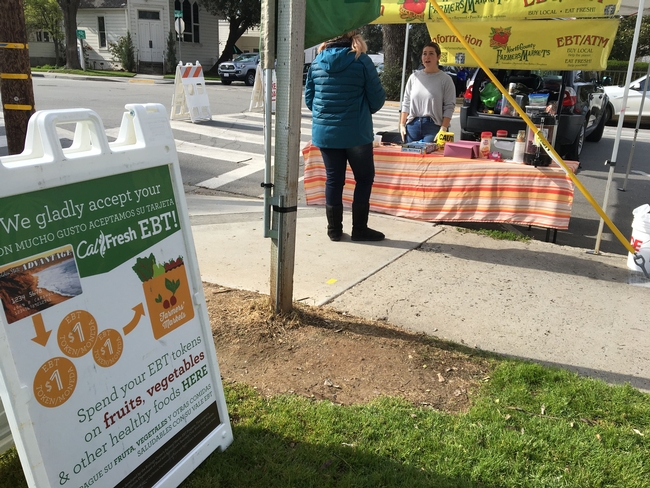Reduction of SNAP benefit deepens crisis of inflation, high cost of living, low wages
Starting this month, many of the estimated 3 million people in the CalFresh program – California's version of SNAP (Supplemental Nutrition Assistance Program) – will be facing hunger and making difficult decisions to meet their most basic needs. In late March, participants received the last of the pandemic-related emergency aid that significantly boosted their monthly benefits. The reduction varies by household size and income; for example, in April a single-person household could see a drop from $281 per month to $23.
“The emergency food allotments had a tremendous impact in our communities and across the nation,” said Shannon Klisch, academic coordinator for the Youth, Families and Communities Program for UC Cooperative Extension in San Luis Obispo and Santa Barbara counties. “One study estimated that these allotments kept more than 4 million people out of poverty across the U.S. in the last quarter of 2021, and reduced child poverty by 14%.”
SNAP increases during the pandemic made many Californians more food-secure, with some participants reporting that their allotments finally had been enough to feed their families for the month, according to Wendi Gosliner, a project scientist at the Nutrition Policy Institute (a program of UC Agriculture and Natural Resources). But, with the benefit reductions, food insecurity is emerging again as a serious concern.
“It is inconceivable that a nation this wealthy should have so many people experiencing hunger,” Gosliner said. “And here in California, with the high cost of living, ongoing inflation and extreme income and wealth disparities, people are being forced to explore every possible avenue just to feed themselves and their families.”
To help ensure they are receiving the maximum allotment, Klisch recommends that CalFresh participants – especially those who applied during the pandemic and are relatively new to the program – double-check their information.
“If the county doesn't have your most up-to-date information, call your county worker if you've changed your address, if you've experienced decreased income, if your housing costs have gone up, or if you have new expenses – like child or dependent care expenses or medical expenses – these can help you qualify for more CalFresh funds,” she explained.
For families with school-aged children, Klisch said they can stretch their food dollars and promote healthy eating by encouraging their children to eat breakfast and lunch at school through California's universal free school meals, and all families with children under 18 can watch for the next issuance of the P-EBT (Pandemic EBT) card, worth potentially hundreds of dollars.
In addition to these options for food assistance, Klisch pointed to programs that can help people save money on other household expenses, such as California Alternate Rates for Energy Programs (CARE) and Affordable Connectivity Program. Local food banks are also gearing up across the state to handle an expected surge in clients in need of emergency food; a list of California food banks can be found at cafoodbanks.org/our-members.
“We ask a lot of low-income families and workers to navigate and piece together various programs, applications, and benefits when we don't commit to a strong safety net,” Klisch said. “On the other hand, when people have enough money for food, everyone benefits through decreased health care costs and increased economic activity.”
Gosliner also said that people should look into their eligibility for WIC (Special Supplemental Nutrition Program for Women, Infants and Children), as well as the federal Earned Income Tax Credit (EITC) and CalEITC, poverty-alleviation benefits underused by Californians.
“People should make sure they are accessing all the safety net benefits for which they are eligible,” Gosliner said.
Market Match, other nutrition incentive programs can help
Through programs like Market Match, available at about 300 farmers markets across California affiliated with the Ecology Center, CalFresh participants can have their EBT benefits “matched” by their local market (usually up to $10 or $15 per visit).
“People are looking to get creative about how to stretch their food dollars, and Market Match is one way to do that,” said Klisch, who has led UCCE efforts to help promote the program along the Central Coast since 2017.
Striving to expand access to fresh fruit and vegetables and to support local farms, UCCE and CalFresh Healthy Living, UC worked with partners to increase CalFresh redemption at farmers markets in San Luis Obispo and northern Santa Barbara counties.
In 2017, about $48,000 in CalFresh and Market Match benefits were redeemed at farmers markets in the area. In 2022, the total was more than $207,000 – a 327% increase. According to Ecology Center figures for the entire state, CalFresh and Market Match spending at farmers markets jumped 161% from 2019 to 2021, up to $13 million.
Gosliner, whose research has shown that these nutrition incentive programs are associated with increased food security, noted that “the people who use Market Match absolutely love the program and feel it is incredibly helpful.” She also added that the California Department of Social Services is developing a pilot program that would offer match incentives for purchasing fruits and vegetables at larger food retailers.
Although the biggest of its kind, Market Match is just one of the programs across California that provide “matches” for healthy food purchases under the California Nutrition Incentive Program, which in turn is primarily funded by GusNIP (the nationwide Gus Schumacher Nutrition Incentive Program).
GusNIP dollars – and SNAP overall – are governed by the federal Farm Bill, typically renewed every five years and currently being negotiated by Congress.

